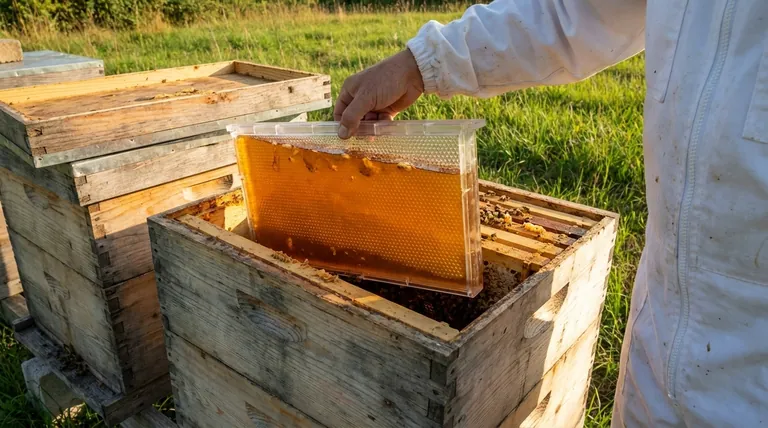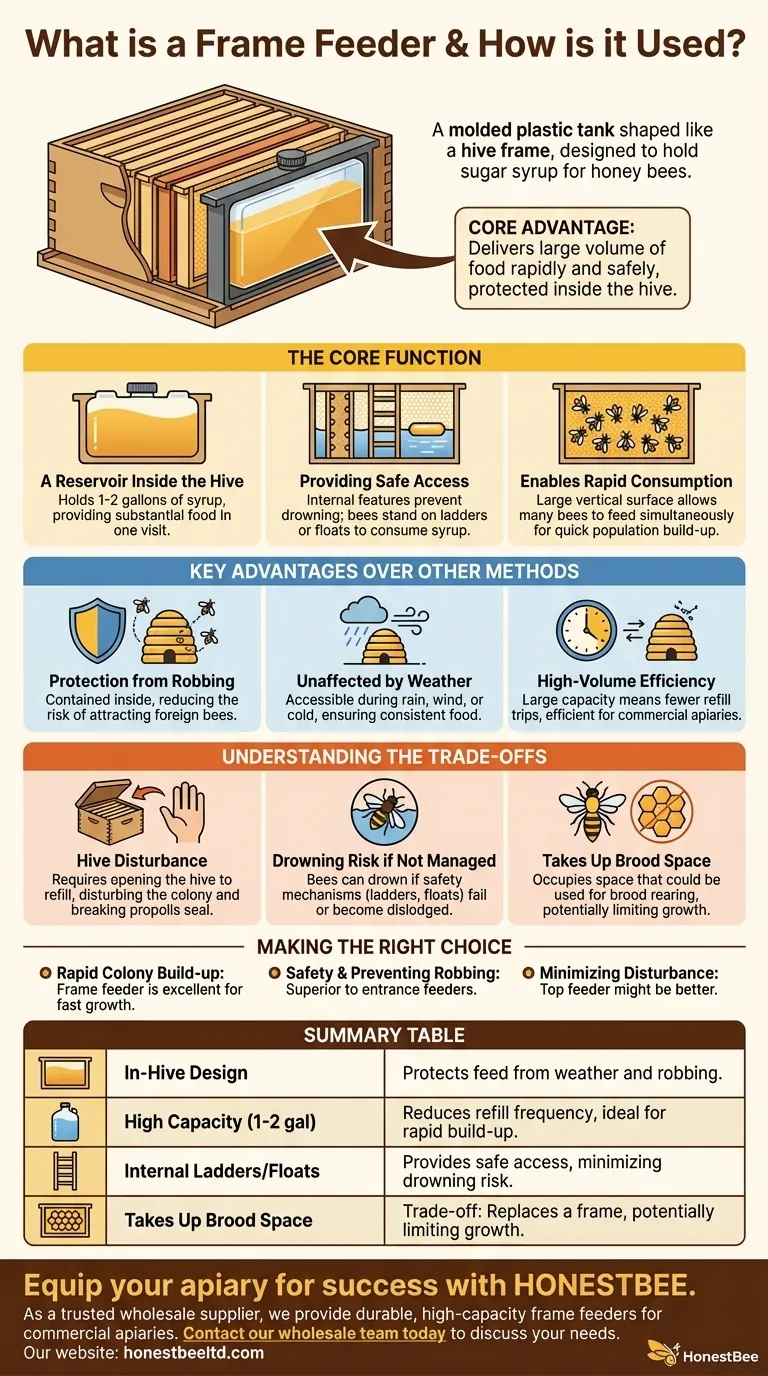A frame feeder is a container shaped like a standard hive frame, designed to hold sugar syrup for honey bees. It is used by replacing one or two frames inside the brood box, allowing bees to access a large volume of food directly within the hive, protected from weather and outside pests.
The core advantage of a frame feeder is its ability to deliver a large volume of food rapidly and safely inside the hive, minimizing the risk of robbing from other colonies and protecting the feed from the elements.

The Core Function of a Frame Feeder
A frame feeder, also known as an in-hive feeder, is a simple but highly effective tool for bee nutrition. Its design directly addresses the needs of a managed colony.
A Reservoir Inside the Hive
A frame feeder is essentially a molded plastic tank shaped to fit perfectly in the space of one or two standard Langstroth frames.
They typically hold between one and two gallons of syrup, allowing a beekeeper to provide a substantial amount of food in a single visit.
Providing Safe Access
The most critical feature of a frame feeder is the mechanism that prevents bees from drowning.
These feeders have an open top for easy filling, but the interior contains features like integrated plastic ladders or rough-textured walls. Beekeepers often add a wooden or plastic float to provide a platform for bees to stand on while they consume the syrup.
Enabling Rapid Consumption
The large, vertical surface area inside the feeder allows a great number of bees to feed simultaneously.
This is especially useful for delivering food quickly when a colony needs to build up its population or stores rapidly, such as in early spring or during a nectar dearth.
Key Advantages Over Other Methods
While other feeders exist, the in-hive frame feeder offers distinct benefits that make it a preferred choice for many beekeepers.
Protection from Robbing
Feeders placed outside the hive, such as entrance feeders, can broadcast the scent of sugar syrup, attracting bees from neighboring hives. This can trigger "robbing," where foreign bees invade to steal resources, a fight that can decimate a weak colony.
Because a frame feeder is entirely contained within the hive, it significantly reduces this risk.
Unaffected by Weather
Since the feeding station is inside the hive, bees can continue to access it during rain, wind, or cool temperatures that would otherwise prevent foraging.
This ensures the colony has a consistent food source to maintain its strength, regardless of external conditions.
High-Volume Efficiency
The large capacity of a frame feeder means fewer trips to the apiary are needed for refills. This makes it an efficient choice for beekeepers managing multiple hives or those with limited time.
Understanding the Trade-offs
No feeding method is perfect. Being aware of the limitations of a frame feeder is essential for using it effectively.
Hive Disturbance is Required
To check the syrup level or refill the feeder, you must open the hive. This breaks the propolis seal and disturbs the colony's internal environment.
This regular disturbance can be a source of stress for the bees, especially if done during cold or windy weather.
Drowning Risk if Not Managed
If the flotation device or ladders become dislodged, coated in syrup, or are otherwise ineffective, bees can fall into the syrup and drown.
It is crucial to ensure the safety mechanism is properly in place every time you fill the feeder.
Takes Up Brood Space
The feeder occupies the space of one or two frames. This is space the queen could otherwise be using to lay eggs and expand the colony's population.
During a strong nectar flow or a period of rapid population growth, this reduction in brood area can be a significant drawback.
Making the Right Choice for Your Goal
Selecting a feeder depends entirely on what you are trying to achieve with your colony.
- If your primary focus is rapid colony build-up: The frame feeder is an excellent choice for delivering large quantities of syrup to stimulate fast growth in the spring.
- If your primary focus is safety and preventing robbing: The frame feeder is superior to entrance feeders, as it keeps all food securely contained within the hive.
- If your primary focus is minimizing hive disturbance: A top feeder might be a better option, as it can often be refilled with less disruption to the brood nest itself.
Understanding these principles allows you to feed your colony effectively and responsibly.
Summary Table:
| Feature | Benefit |
|---|---|
| In-Hive Design | Protects feed from weather and prevents robbing by other bees. |
| High Capacity (1-2 gal) | Reduces refill frequency; ideal for rapid colony build-up. |
| Internal Ladders/Floats | Provides safe access to syrup, minimizing drowning risk. |
| Takes Up Brood Space | Trade-off: Replaces a frame, potentially limiting colony growth. |
Equip your apiary for success with HONESTBEE.
As a trusted wholesale supplier for commercial apiaries and beekeeping equipment distributors, we provide the durable, high-capacity frame feeders and equipment you need to support strong, productive colonies. Our products are designed for efficiency and bee safety, helping you manage your operations effectively.
Contact our wholesale team today to discuss your needs and see how we can support your business.
Visual Guide

Related Products
- Boardman Entrance Bee Feeder Durable Galvanized Steel and Wood Construction for Beekeeping
- Professional In-Hive Frame Bee Feeder by HONESTBEE
- 3.5L Plastic Beehive Frame Feeder Deep Frame Water Feeder for In Hive Use
- Classic Boardman Entrance Bee Feeder Hive Front Feeding Solution
- Professional Hive Front Entrance Bee Feeder
People Also Ask
- What is an entrance feeder? A Guide to Its Simple Design and High Robbing Risk
- How does an entrance feeder work? A Guide to Its Simple Mechanics and Risks
- What types of bee feeders are available for beginners? Start with the Simple Entrance Feeder
- How do you make an entrance feeder for bees? A Guide to Safe & Effective Hive Feeding
- What are the different types of feeders available for beehives? A Guide to Entrance, Hive-Top, and Frame Feeders



















